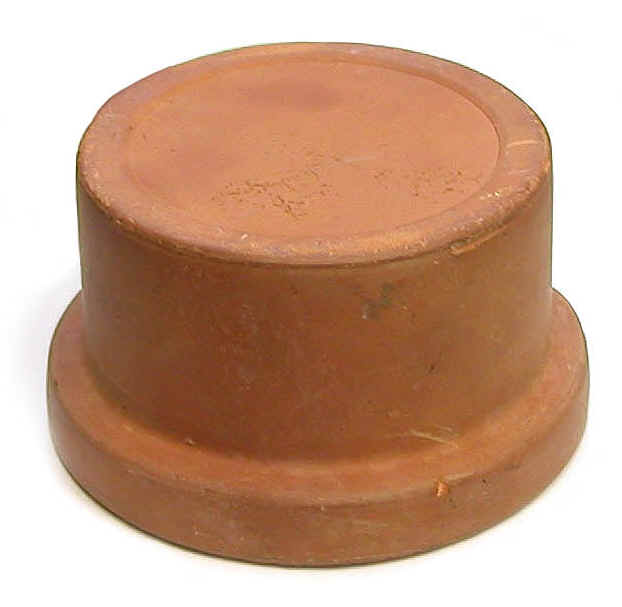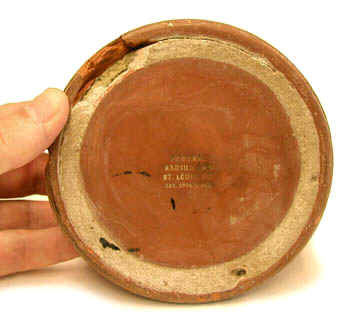Federal Radium Lab Emanator (ca. 1927-1935)


This emanator was produced by the Federal Radium Laboratory of St. Louis, Missouri. It appears to be nothing more than a clay flower pot with uranium ore (possibly purified radium) sealed inside. A fair bit of ore (or radium) as a matter of fact. As a rough approximation, it contains 5 uCi of radium-226.
When the emanator was placed in water, radon gas produced by the decay of the radium would dissolve in the water. Drinking such radioactive water would help people get well and stay well. It might even have been recommended for plants and animals.
Size: ca. 4.5" in diameter and 2.5" high
Exposure Rate: ca. 50 uR/hr above background at one foot
The Federal Radium Laboratory
Unfortunately, I haven't managed to obtain much information about the company.
The Federal Radium Laboratory was listed in the 1933 St. Louis City Directory, but I could not find it in the directory for any other year. The 1933 entry identified the principals in the company as Joseph and Chester Vorbeck. The latter was Joseph's son. The company address, 775 Goodfellow Boulevard, also happened to be the Vorbeck residence.
The earliest mention of the Federal Radium Laboratory that I have found was in an article in the August 24, 1926 issue of the St. Louis Post-Dispatch. The newspaper was reporting on a fire in the de Baliviere Building at the corner of de Baliviere and McPherson avenues. Federal Radium Laboratory, one of the nine stores occupying the building's first floor, was heavily damaged. Perhaps this experience convinced Vorbeck that he was better off running the business from his home.
The Federal Radium Laboratory seems to have been a small operation, and I can't rule out the possibility that it operated well after 1935. There are indications that Vorbeck might have produced literature referencing the company even after he moved to California (ca. 1940).
The Vorbeck Radium Jar
The only other Federal Radium Laboratory product that I know of was the Vorbeck Radium Jar. The latter was a cylindrical ceramic pot (ca. 12" high and 12" in diameter") with a tan glaze. Its radioactive source consisted of three emanator disks placed in the bottom of the jar. I suspect that the "flower pot" emanator shown above might have been one of these "disks"and that it became separated from the jar. It is equally possible that the emanator might have been sold separately—as long as it could fit inside a container, it could produce "radiumized water."
According to some promotional literature in the possession of the Missouri History Museum, Vorbeck invented the jar in 1927. Its purpose was to charge
"ordinary water for drinking or bathing with atomic energy or natural electrically charged light rays called radioactivity—in the form of the gas radium emanation of radon... In 1925, in St. Louis, Missouri, Dr. Vorbeck established his own laboratories in which were processed the radium bearing ores for the recovery of the Radium employed in his own professional work."
A newspaper advertisement/article from 1932 (San Antonio Light Feb. 28, 1932) promoted the "Vorbeck Radium Fountain for supplying radioactive drinking water in the home." Undoubtedly, this is a reference to the Vorbeck Radium jar.
My best guess would be that the jar and the emanator were produced from 1927-1935, but it is entirely possible that the jar was being sold much later than that. There are some indications that "J.C. Vorbeck Laboratories" was selling a "Vorbeck Radioactive Water Generator" in 1941 by which time Vorbeck was living in California.
Joseph C. Vorbeck
1879 Chester Joseph Vorbeck is born October 22 in Pacific, Missouri. His mother Margaret is 16 years old
1891 The Vorbecks are living in St. Louis
1898 Chester's father, Joseph Vorbeck, dies
1900 Chester Vorbeck, now 20 years old, is living with his mother. Both are identified as physicians in the census
1901 Chester Joseph Vorbeck changes his name to Joseph Chester Vorbeck (after his father)
1902/1903 Joseph marries Julia
1925 Vorbeck publishes a booklet: Radium Therapy
1938 The Vorbecks are in Ventura California. The City Directory identifies him as a physician.
1940 Vorbeck is in Ventura California. The 1940 census describes him as an entry technician
1942 In the Ventura City Directory his name is followed by "X-ray labtry"
1946, 1949 and 1956 The Ventura City Directory describes him as a physician
1958 Joseph Chester Vorbeck dies
For most of his life, he earned his living as a physician in St. Louis. Regarding his education, all I know is that the 1940 census (conducted when he was 60 years old) indicated that he had four years of college.
Radium Products Company (ca. 1923-1930)
In the mid 1920s, Vorbeck served as the medical director for the Radium Products Company located at 537 N Grand Boulevard (Room 406) in St. Louis. For what its worth, I have two other addresses for them: 5247 Vernon Avenue and 5617 Page Boulevard. The company's president was Joseph G. Beckman. It was
"a $5,000,000 corporation which was to establish "restariums" where "Radio-active Chemical Baths" were to be given to those suffering from what were considered incurable ailments" (St. Louis Star and Times. Dec. 6, 1924).
In fact, Vorbeck applied for a city permit to open such a sanitarium at 775 Goodfellow Avenue (Vorbeck's residence and the future home of his Federal Radium Laboratory). According to the St. Louis Star and Times (July 26, 1924) he claimed that he could treat all manner of disease using the company's radioactive process. To their credit, the city turned down the application.
It might be unfair to suggest this, but the real purpose of the Radium Products Company was probably to sell worthless shares of stock to gullible clients. One J.H.F. Smokey, who filed a suit against Radium Products Company and Vorbeck for the unauthorized use of his formula for a "Radium Active Chemical Bath," described the Ten Commandments that Radium Products gave the salesmen who sold stock in the corporation. My favorite commandment:
"Humor your prospect like a child if he is unable to see and realize the greatness of your offering... Put on your face the expression of sympathy for his weakness... Use your reserved refinement, culture and education to leave a regret in his heart."
Donated by Ed Bailey.
